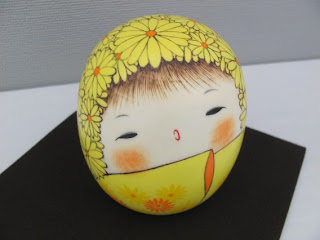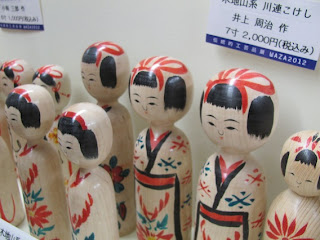 O
Ok, this is it. I have finally made it to the last blog installment of our great summer 2011 kokeshi adventure. A bit late, yes, but essential because, after all, our jaunt up north to Tohoku was the very definition of a kokeshi adventure as defined by me, a guy who writes a blog called "Kokeshi Adventures." But I digress.
On the morning of 27 June we departed Akita and headed south through the mountains into Yamagata Prefecture 山形県. Yamagata is known for its cherries, and cherry trees just dripping with fruit were everywhere along the side of the national road that connected Yamagata to Akita. The prefecture is heavily agricultural and cherries are one of its specialties. Yamagata is also known for kokeshis, and we were on our way to a day trip at Tendo Onsen 天童温泉 where there were at least two kokeshi workshops we were hoping to visit.

Before continuing I should say something about Yamagata's kokeshis. There are actually two different types found there: Zao-Takayu 蔵王高湯系 and Yamagata 山形系. In my opinion Yamagata's do not have a particularly distinctive look that makes one say "that's a Yamagata!" On the other hand, Zaos are very distinct, despite some variety within the type, because of their use of darker woods, an interesting torso shape that's different from other kokeshis, and (often) a shock of black hair with a small red dot in the middle. But these are just indicators that one is looking at a Zao, versus clear kokeshi types such as Tsugaru and Kijiyama.
Anyway, when we arrived at Tendo we couldn't help but notice that the town's identity wasn't kokeshis, or even onsens, but rather the game of shogi 将棋 (Japanese chess). That was actually really cool, and something of a surprise. Meanwhile, we drove around somewhat blindly for a bit until finally stumbling across Eishundo 栄春堂, a shop devoted to shogi, kokeshis, and the people who make them. We had arrived. There was a small museum in the back (which is how we entered), as well as work areas for shoji craftsmen. Most interesting to us, of course, was kokeshi craftsman Mr. Aida Eiji's 会田栄治さん work area. Unfortunately he wasn't at his station so we didn't get to talk with him. Furthermore, there didn't seem to be anybody in the shop who knew much about kokeshis. Too bad. We did, however, find a couple of really nice pieces by Mr. Aida before we left the store. After that we drove to destination number two: The workshop of Mr. Mito Hiroshi 水戸寛さん, about which I'll continue below.
 |
| Mr. Aida's work area and his kokeshis. |
 |
| A little souvenier from Eishundo. It's a hybrid kokeshi-shogi piece, a knickknack really. Interesting, though I didn't get one. |
 |
| Mr. Aida's unique kokeshis for sale in the shop. We bought one of the ones with the large head -- do you see it? |
 |
| A kokeshi noren. |
 |
| The front of the shop. Tendo is a really a nice little city in a beautiful area. |
Mito Kokeshi 水戸こけし wasn't too far away, but it wasn't necessarily easy to find either and Naoko had to call and get directions. I'll say up front that I'm really glad our kokeshi trip ended up here, since Mr. Mito -- 89 years old -- is a master craftsman who, I would argue, is in his own category. What do I mean by that? Well, he's been making kokeshis since 1955, so he really knows what he's doing when it comes to lathing and painting. But there's something about the refinement of his work that is different from other craftsmen we met. While I don't have time to get too much into his work, I would like to mention Mr. Mito's tiny kokeshis which are the smallest I've seen, and when you look closely you'll see that they are also 100% Mito kokeshis in terms of the faces and patterns. I will definitely be doing a blog in the future specifically on Mr. Mito's work.
We were at Mito Kokeshi for at least 90 minutes, but possibly two hours, chatting with both Mr. and Mrs. Mito who apparently had lots of time to spare. It was still fairly close to 3-11, so besides kokeshis the disaster was the main topic for discussion. Like other places we had visited Tendo had its share of refugees from the area that had been hit by the tsunami.
While we were there nobody else came into the shop, so we were able to examine everything fully, and ended up picking an ejiko えじこ (hollow kokeshi with removable head) that had multiple tiny kokeshis inside it, plus a regular Zao type, a hollow Daruma containing multiple tiny darumas, and a couple of other pieces. All fantastic, and Mr. Mito's kokeshis are easily some of my favorites in our collection.
 |
| The front of Mito Kokeshi in the heart of Tendo City. |
 |
| Mr. Mito's Zao type kokeshis. His faces are just delightful and are identical to those on even his tiniest kokeshis. |
 |
| Mr. Mito also makes Darumas, and if you twist the top off there's a number of small Darumas inside. Naoko got this one. |
 |
| Mr. Mito at his lathe demonstrating how to make a tiny kokeshi. He has made his own tools and brushes that allow him to get down to a tiny size. |
 |
| A nearly completed tiny kokeshi. I watched him make this miniature work of art -- unbelievable. |
 |
| A pile of Mr. Mito's tiny kokeshis. He produces these at a progidous rate. Note that each one has his signature on the bottom. Click on the photo for a closer look. |
 |
| Not a bowl of candy, but kokeshis! |
 |
| Mr. Mito makes lots of ejiko えじこ, and fills each with his tiny kokeshis as an added bonus. Highly, highly recommended for serious enthusiasts. |
We finally bid Mr. and Mrs. Mito a fond, fond farewell and made our way to the highway for a long drive through the mountains to Miyagi Prefecture, and then south to Mashiko Town in Tochigi Prefecture where we stayed at our favorite bed and breakfast. In our trunk was a week's worth of kokeshi purchases that now make up the heart of our collection. But had it really been a week? In a sense Naoko, the girls and I had lived a lifetime as kokeshi adventurers, but in the end it was, as the Japanese used to say, like a dream within a dream.
I can't wait to do it again.

 Before continuing I should say something about Yamagata's kokeshis. There are actually two different types found there: Zao-Takayu 蔵王高湯系 and Yamagata 山形系. In my opinion Yamagata's do not have a particularly distinctive look that makes one say "that's a Yamagata!" On the other hand, Zaos are very distinct, despite some variety within the type, because of their use of darker woods, an interesting torso shape that's different from other kokeshis, and (often) a shock of black hair with a small red dot in the middle. But these are just indicators that one is looking at a Zao, versus clear kokeshi types such as Tsugaru and Kijiyama.
Before continuing I should say something about Yamagata's kokeshis. There are actually two different types found there: Zao-Takayu 蔵王高湯系 and Yamagata 山形系. In my opinion Yamagata's do not have a particularly distinctive look that makes one say "that's a Yamagata!" On the other hand, Zaos are very distinct, despite some variety within the type, because of their use of darker woods, an interesting torso shape that's different from other kokeshis, and (often) a shock of black hair with a small red dot in the middle. But these are just indicators that one is looking at a Zao, versus clear kokeshi types such as Tsugaru and Kijiyama.














































